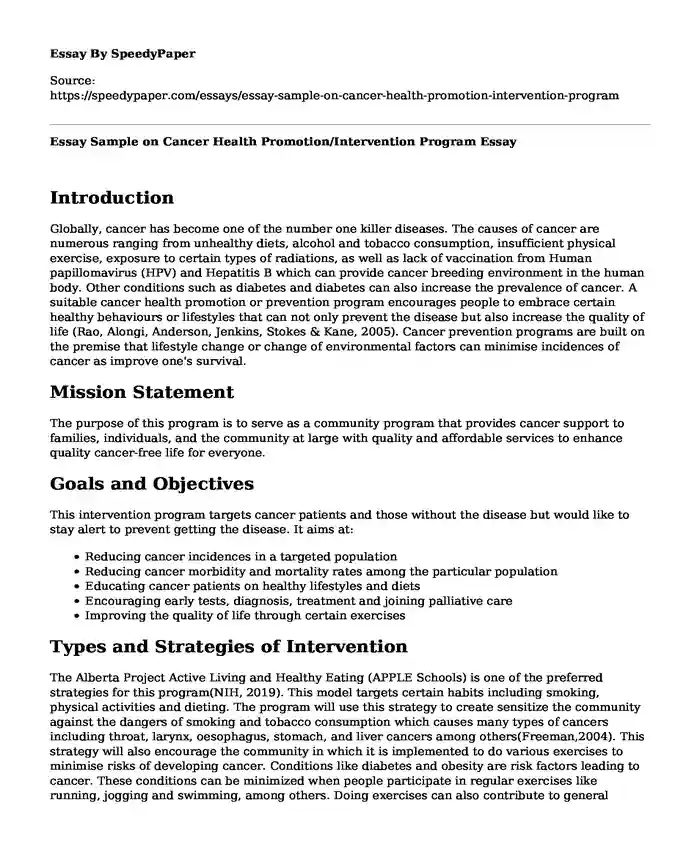Introduction
Globally, cancer has become one of the number one killer diseases. The causes of cancer are numerous ranging from unhealthy diets, alcohol and tobacco consumption, insufficient physical exercise, exposure to certain types of radiations, as well as lack of vaccination from Human papillomavirus (HPV) and Hepatitis B which can provide cancer breeding environment in the human body. Other conditions such as diabetes and diabetes can also increase the prevalence of cancer. A suitable cancer health promotion or prevention program encourages people to embrace certain healthy behaviours or lifestyles that can not only prevent the disease but also increase the quality of life (Rao, Alongi, Anderson, Jenkins, Stokes & Kane, 2005). Cancer prevention programs are built on the premise that lifestyle change or change of environmental factors can minimise incidences of cancer as improve one's survival.
Mission Statement
The purpose of this program is to serve as a community program that provides cancer support to families, individuals, and the community at large with quality and affordable services to enhance quality cancer-free life for everyone.
Goals and Objectives
This intervention program targets cancer patients and those without the disease but would like to stay alert to prevent getting the disease. It aims at:
- Reducing cancer incidences in a targeted population
- Reducing cancer morbidity and mortality rates among the particular population
- Educating cancer patients on healthy lifestyles and diets
- Encouraging early tests, diagnosis, treatment and joining palliative care
- Improving the quality of life through certain exercises
Types and Strategies of Intervention
The Alberta Project Active Living and Healthy Eating (APPLE Schools) is one of the preferred strategies for this program(NIH, 2019). This model targets certain habits including smoking, physical activities and dieting. The program will use this strategy to create sensitize the community against the dangers of smoking and tobacco consumption which causes many types of cancers including throat, larynx, oesophagus, stomach, and liver cancers among others(Freeman,2004). This strategy will also encourage the community in which it is implemented to do various exercises to minimise risks of developing cancer. Conditions like diabetes and obesity are risk factors leading to cancer. These conditions can be minimized when people participate in regular exercises like running, jogging and swimming, among others. Doing exercises can also contribute to general wellness and prevent other associated disease like hypertension and heart failure (Lee, 2003). This program can also liaise with schools and other social welfare centres to sensitise communities to have healthy diets that exclude foods that might escalate chances of getting cancer.
Education is another helpful strategy in which communities can learn about cancer, its effects, and how it can be prevented (Rao et al., 2005). School children should be taught about cancer from a young age. The elderly and adults can also be taught how to prevent and manage cancer through manuals and community outreach programs. Awareness campaigns can also be used to raise concern on cancer. These campaigns can be done through posters, flyers and other channels like social media or displays at social centres.
Settings
Schools present ideal settings in which these programs can be done because school children need these programs to learn about cancer. Adults within the school settings can also benefit from these programs as they can learn how to take care of themselves. Clinics, hospitals and community health centres can be ideal places as those who attend these places for screenings, diagnosis, tests, and chemotherapy among others must learn ways through which they can manage themselves (Rao et al., 2005). Those who do not have cancer can also learn what to do not to have it.
Conclusion
Cancer intervention programs seek to create awareness on the disease and promote healthy living behaviours and lifestyles that include balanced diets, physical activities, avoidance of smoking, moderate or no alcohol consumption, avoidance of exposure to dangerous agents like radiation, and many others. This intervention program promotes these behaviours through the use of the Alberta Project Active Living and Healthy Eating model, education and awareness campaigns as preferred intervention strategies. The settings for implementation include schools, hospitals, clinics and community healthcare centers.
References
Freeman, H. P. (2004). Poverty, culture, and social injustice: determinants of cancer disparities. CA: A Cancer Journal for Clinicians, 54(2), 72-77.
Lee, I. M. (2003). Physical activity and cancer prevention--data from epidemiologic studies. Medicine and science in sports and exercise, 35(11), 1823-1827.
NIH. (2019). Research-Tested Intervention Programs: Program Details. Retrieved from https://rtips.cancer.gov/rtips/programDetails.do?programId=3624004
Rao, J. K., Alongi, J., Anderson, L. A., Jenkins, L., Stokes, G. A., & Kane, M. (2005). Development of public health priorities for end-of-life initiatives. American Journal of Preventive Medicine, 29(5), 453-460.
Cite this page
Essay Sample on Cancer Health Promotion/Intervention Program. (2023, Mar 16). Retrieved from https://speedypaper.com/essays/essay-sample-on-cancer-health-promotion-intervention-program
Request Removal
If you are the original author of this essay and no longer wish to have it published on the SpeedyPaper website, please click below to request its removal:
- Field of Honor - Free Essay on the Book Review
- Float System Research: Free Essay on Capital Controls in Malaysia
- Free Essay on Leadership in Criminal Justice Organizations
- Management Essay Example on Business Analysis Process
- Business Essay Sample: Food Truck in Hong Kong
- Essay Example about Marketing Mix in Global Marketing
- The United States Is Not Really a Democracy - Essay Example
Popular categories





